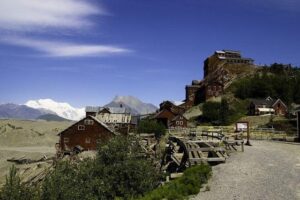 When the minerals in a mine run out, or become less valuable, the mine tends to close down. These days, they try to return the mine to it’s prior state, but then many mines these days are pit mines, or strip mines. I suppose it is easier to return them to their prior state when you only have to fill in the hole, and I’m not opposed to that process. It can make a beautiful place out of ground that has been ripped apart. In some cases, it looks better after the reclamation.
When the minerals in a mine run out, or become less valuable, the mine tends to close down. These days, they try to return the mine to it’s prior state, but then many mines these days are pit mines, or strip mines. I suppose it is easier to return them to their prior state when you only have to fill in the hole, and I’m not opposed to that process. It can make a beautiful place out of ground that has been ripped apart. In some cases, it looks better after the reclamation.
The Kennecott Mine, often spelled Kennicott, is an abandoned mining camp in the Valdez-Cordova Census Area, which is now the Copper River Census Area in the state of Alaska. The mine was, at one time, the center of activity for several copper mines. Kennecott Mines was named after the Kennicott Glacier in the valley below. The geologist Oscar Rohn named the glacier after Robert Kennicott during the 1899 US Army Abercrombie Survey. A “clerical error” resulted in the substitution of an “e” for the “i,” supposedly by Stephen Birch himself. The mine is located northeast of Valdez, inside Wrangell-Saint Elias National Park and Preserve. The camp and mines are now a National Historic Landmark District administered by the National Park Service. It was declared a National Historic Landmark in 1986. It’s status as a historical site, probably explains the good shape it is in. Many historical sites deteriorate badly before anyone realizes that they should be preserved as a part of history.
Two prospectors, “Tarantula” Jack Smith and Clarence L Warner, who were with a group of prospectors associated with the McClellan party in the summer of 1900, spotted “a green patch far above them in an  improbable location for a grass-green meadow.” Upon inspection, the green turned out to be malachite, located with chalcocite…aka “copper glance,” and the location of the Bonanza claim. A few days later, Arthur Coe Spencer, US Geological Survey geologist also found chalcocite at the same location. It was the birth of a copper mine.
improbable location for a grass-green meadow.” Upon inspection, the green turned out to be malachite, located with chalcocite…aka “copper glance,” and the location of the Bonanza claim. A few days later, Arthur Coe Spencer, US Geological Survey geologist also found chalcocite at the same location. It was the birth of a copper mine.
A mining engineer just out of school, named Stephen Birch was in Alaska looking for investment opportunities in minerals. He was young, but he came with the financial backing of the Havemeyer Family and another investor named James Ralph, from his days in New York. Birch spent the winter of 1901-1902 acquiring the “McClellan group’s interests” for the Alaska Copper Company of Birch, Havemeyer, Ralph and Schultz, later to become the Alaska Copper and Coal Company. He spent the summer of 1901, visiting the property and “spent months mapping and sampling.” He confirmed the Bonanza mine and surrounding deposits, were at the time, the richest known concentration of copper in the world.
Kennecott had five mines: Bonanza, Jumbo, Mother Lode, Erie, and Glacier. “Glacier, which is really an ore extension of the Bonanza, was an open-pit mine and was only mined during the summer. Bonanza and Jumbo were on Bonanza Ridge about 3 miles from Kennecott. The Mother Lode mine was located on the east side of the ridge from Kennecott. The Bonanza, Jumbo, Mother Lode and Erie mines were connected by tunnels. The Erie mine was perched on the northwest end of Bonanza Ridge overlooking Root Glacier about 3.7 miles up a glacial trail from Kennecott.” The copper ore was transported to Kennecott by way of the trams which head-ended at Bonanza and Jumbo. From Kennecott the ore was hauled mostly in 140-pound sacks on steel flat cars  to Cordova, 196 rail miles away on the Copper River and Northwestern Railway (CRNW).
to Cordova, 196 rail miles away on the Copper River and Northwestern Railway (CRNW).
In 1925 a Kennecott geologist predicted that the end of the high-grade ore bodies was in sight. The mines days were numbered. The highest grades of ore were largely depleted by the early 1930s. The Glacier Mine closed in 1929, and the rest followed soon after. The last train left Kennecott on November 10, 1938. It was now a ghost town. Over a period of 20 years the population dropped from 494 in 1920 to 5 in 1940. Thankfully the historical value of this particular site was not lost, and is still there today.


Leave a Reply